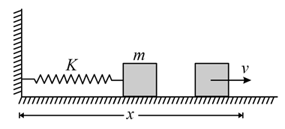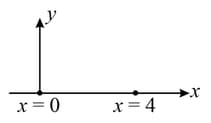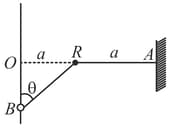Figure shows a rod of length which is uniformly charged with linear charge density kept on a smooth horizontal surface. Right end of rod is in contact with a vertical fixed wall. A block of mass m and charge q is projected with a velocity from a point very far from rod in the line of rod. Find the distance of the closest approach between the block & the left end of the rod.



Important Questions on Work, Energy and Power
A non-conducting disc of radius and uniform positive surface charge density is placed on the ground with its axis vertical. A particle of mass and positive charge is dropped along the axis of the disc from a height with zero initial velocity. The particle has, .
(i) Find the value of if the particle just reaches the disc.
(ii) Sketch the potential energy of the particle as a function of its height and find its equilibrium position.
A block of mass is pushed against a spring of spring constant fixed at one end to a wall. The block can slide on a frictionless table as shown in the figure. The natural length of the spring is and it is compressed to one-fourth of the natural length and the block is released. Find its velocity as a function of its distance from the wall and the maximum velocity of the block. The block is not attached to the spring.

A block of mass rests on a rough horizontal plane having a coefficient of kinetic friction and coefficient of static friction . The spring is in its natural length when a constant force of magnitude acting on the block. The spring force is a function of extension . (Where is spring constant)

Comment on the relation between and for the motion to start.
Find the maximum extension in the spring. (Assume the force is sufficient to make the block move)
A particle of mass lying on -axis experiences a force given by law

where is the -coordinate of the particle in meters.
Locate the points on -axis where the particle is in equilibrium.
Draw the graph of variation of force (-axis) with -coordinate of the particle (-axis). Hence or otherwise indicate at which positions the particle is in stable or unstable equilibrium.
What is the minimum speed to be imparted to the particle placed at such that it reaches the origin.
A small bead of mass is free to slide on a fixed smooth vertical wire, as indicated in the diagram. One end of a light elastic string, of unstretched length and force constant is attached to . The string passes through a smooth fixed ring and the other end of the string is attached to the fixed point , being horizontal. The point on the wire is at same horizontal level as , and .
(i) In the equilibrium position, find .
(ii) The bead is raised to a point of the wire above , where , and is released from rest. Find the speed of the bead as it passes , and find the greatest depth below of the bead in the subsequent motion.

A particle of mass approaches a region of force starting from The potential energy function in terms of distance from the origin is given by,
for
for where (positive constant)
(a) Derive the force and determine whether it is repulsive or attractive.
(b) With what velocity should the particle start at to cross over to other side of the origin.
(c) If the velocity of the particle at is towards the origin describe the motion.
